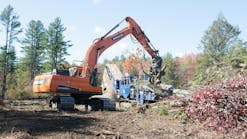Excavators are getting much smarter these days. With advanced engine and hydraulics technology, they can do more work than ever with a gallon of fuel. And with global positioning systems (GPSs) and wireless communications, they can tell the office folks what they’re doing and warn of any impending ailments.
Take Volvo excavators, for example. New models come with the V-ACT system, which stands for Volvo Advanced Combustion Technology. According to Tony den Hoed, excavator-marketing specialist, major V-ACT features include:
- a new flexible, high-pressure fuel-injection system with latest-generation unit injectors;
- a new air-management system that incorporates a patented exhaust gas recirculation system, a new standard turbocharger and a new air-to-air charge air cooler; and
- an enhanced electronic controller for precise control of the fuel and air handling systems.
With V-ACT, no external devices or after-treatment of the exhaust gases are required to meet the EPA’s Tier 3 emission standards. Low-sulfur fuel is not required for Volvo engines that have V-ACT.
At Caterpillar, the 345D L excavator replaces the 345C L. Engine horsepower has been increased by 10%, yet the newer model uses about the same amount of fuel in tough digging, high duty-cycle applications, says Kent R. Pellegrini, sales support consultant.
The improved fuel efficiency is made possible by Cat’s Advanced Diesel Engine Management controller—and a new electric regeneration system in the boom’s hydraulic circuit. “The benefits are increased power and flat torque curves,” says Pellegrini. “Plus, our easily selectable power settings offer industry-leading productivity while reducing fuel consumption in less demanding applications.”
To conserve fuel during light-duty work, the hydraulic and engine control system on the Cat 345D has been redesigned to include a new power management feature. The operator can select from three alternative engine and hydraulic power settings without sacrificing breakout force or lift capacity.
Those alternative power options are HHP (high horsepower), SP (standard power), and Eco (economy). To maximize the production of the machine you would use the HHP mode when digging or lifting. Reducing to standard mode also reduces the amount of work the machine can complete. In standard mode, the engine torque curve changes, the engine slows slightly, and pump flow is reduced. In Eco mode, the torque curve is the same as the SP mode, but the engine slows a bit more and pump flow is further reduced.
Engines and Hydraulics
John Deere recently introduced two new hydraulic excavators in the 12- to 13.5-metric-ton range: the 120D and the 135D. “Both of these machines have the hallmarks of our D-Series, including our Powerwise III engine and hydraulic management system for smooth power and fuel savings, and roomy, comfortable cabs with great visibility,” said Mark Wall, Deere’s excavator product marketing manager. The engines have a set of torque curves, and the hydraulic system has a set of power curves. “Powerwise is the blending of the strengths of the two systems into one operational system that maximizes productivity and fuel efficiency,” says Wall.
On Hitachi excavators, what John Deere calls Powerwise III is called a HIOS III engine/hydraulic management system. HIOS stands for Human and Intelligent Operation System, and it does the same thing Powerwise does.
One of three modes can be selected on Deere excavators to match the engine speed to operating conditions and the application. Those modes are economy, power, and high power. The three modes are offered on every John Deere excavator from the 120D size and larger, up through the 850D LC.
Those engine-speed modes are different from modes such as boom priority and swing priority. “We don’t have those,” says Wall. “Those are all built into one work mode on our machines.”
Kobelco offers an Intelligent Total Control System (ITCS), which provides sensitive, direct control of machine hydraulics. “With some units out there, you can move the boom control a quarter- to a half-inch, and nothing happens,” says Paul Golewicz, brand-marketing manager for Kobelco North America. “But with our Tier 3 units, the electronics that control the hydraulics have been totally upgraded. The difference is the controllability and the smoothness. You not only get the high breakout force that we’re known for, you get the fine leveling and grading ability.“For example, if you’re doing a bucket dig-in function, ITCS will provide power that is proportional to what you’re doing,” says Golewicz. “ITCS maximizes the output and efficiency of the hydraulics system.”
Regenerative Hydraulics
A number of manufacturers, including Case Construction Equipment, now have applied what they call regenerative hydraulics to excavators. The Case CX350B, CX700B, and CX800B now have regenerative hydraulics. “In a nutshell, regenerative hydraulics use the returning oil from one side of a cylinder to boost speed, which decreases cycle times and boosts productivity,” says Mitchell Blake, Case brand marketing manager.
Engines in the Case CX B series excavators have a high-pressure, common-rail fuel system that allows complete electronic control over the engine. “This system boosts horsepower, increases torque, and lowers fuel consumption, all while reducing noise,” says Blake. “With the onboard control system, a Case excavator operator can match the correct hydraulics and engine power to the specific task at hand. Case excavators have a standard, heavy, and auto mode from which to choose.”
Hyundai touts what it calls its patented Posi-Nega Hydraulic Control System. It combines the reliability and simplicity of a negative control system with the additional fine controllability achieved through a positive control hydraulic system. “The operator’s feel and control over the attachment when grading or in precision lifting applications are significantly improved with this new system,” says Corey Rogers, Hyundai sales training manager.
What’s more, Rogers says all excavators in the recently introduced Hyundai 9 series have engines equipped with engine control unit modules that communicate engine data back and forth with the main control unit. Hyundai’s newly designed electronic control system is known as CAPO, for computer-aided power optimization. CAPO optimizes engine performance for fuel efficiency and power.
Doosan Infracore America offers a full excavator line that includes 15 models ranging from 14 to 52 tons. Doosan’s electronic control unit (ECU) communicates with an Electronic Power Optimizing System (EPOS) “to provide one of the best fuel efficiencies in the industry,” says Bill Metzgar, Doosan’s sales and service training manager.
“The EPOS reads all of the sensors on the engine and the electronic fuel injection system—and it reads the hydraulic outputs to optimize our hydraulic and engine performance,” says Metzgar.
What differentiates Doosan’s excavators from the competition is their simplicity, says Metzgar. “Our electronics are as sophisticated as anyone’s, but very simple to the operator and to the technician,” he explains. “A technician can read every input and output right off the monitor in the cab, and he can calibrate the machine with his laptop computer.”
Metzgar says if a Doosan excavator loses its EPOS system, the machine will default to a standard mode and keep right on going. Some machines go down completely if the electronics fail, Metzgar says.
GPS Systems
Most well-known excavator manufacturers offer systems that communicate machine health and operating information to an office computer using Global Positioning Technology and wireless communications. Komatsu America is a leader in this area with its Komtrax system. With only one exception, all current models, from the compact PC18MR-3 to the PC800LC-8, come standard with Komtrax systems. The exception is the compact PC78UU-6.
The Komtrax system can communicate real-time information about location, geofencing, service meter reading, operation maps, fuel level, water temperature, caution warnings, working hours, load frequency, average hourly fuel consumption, and more—all back to an office computer. The Komtrax Web application allows you to see all machine information using easy-to-view maps, graphs, and charts. A variety of search parameters are available to quickly find information about specific machines based on key factors such as utilization rates, age, various notification messages, and more.
Komatsu markets the Komtrax system as an effective way to provide a complete and accurate machine life history when it’s time to sell or trade in the machine. Such a life history may help resale value, the company says.
Volvo offers CareTrack, which works in a similar fashion. With CareTrack, two things need to be installed in the machine: a small computer with an integrated GPS receiver and modem, and an antenna. After that the machine is always online when it is operated, and you can get the machine health information you need via the Internet—at any time, from any place. In areas where the mobile telephone network is not in place, the information is sent via GPS satellite.Both Doosan Infracore and Hyundai now offer GPS for monitoring excavator health. Hyundai’s new 9 Series machines come standard with a newly developed GPS/satellite remote management system that transmits data to a central server, accessible through the Internet. End users and dealers can access performance data, diagnostic information, and machine location information from anywhere in the world. The system will also send real-time machine alerts through e-mail and text messaging directly to end users and dealers.
Short-Radius Machines
Last October, Komatsu introduced the PC88MR-8 midsized excavator. Like many other machines these days, this model features a short-swing radius for access to tight job sites. The 8-ton-class machine bridges the gap between compact and full-sized units. The PC88MR-8 gets its power from a Komatsu Tier 3, 65-horsepower engine, which has 17% more power than the prior model, a PC78MR-6.
In March 2008, Komatsu introduced two new compact excavators, the PC35MR-3 and the PC45MR-3. Both machines are short-tail-swing units. The PC35MR-3 has an operating weight of about 4 tons; the PC45MR-3 has an operating weight of a little more than 5 tons. Komatsu offers three short-radius swing models in construction size—the PC 138USLC-8; the PC 228USLC-3; and the PC 308USLC-3.
John Deere’s 75D offers reduced tail swing and 360-degree rotation.
Volvo offers three short-radius machines. They are the ECR145CL, at about 33,000 pounds; the ECR235CL, at 55,400 pounds; and the ECR305CL, at about 77,000 pounds. Tony den Hoed says the ECR cabs are designed to stay within the track radius. The front corner of the cab has been modified with a radius. The door is on tracks, and the left-hand console tips up for ease of access.
“It appears that the number of reduced-tail-swing models, as a percentage of the total population sold, has stabilized,” says Wall of John Deere. “It has taken contractors a few years to get used to it. The newness has worn off.”
Reduced-tail-swing models cost a bit more to buy, compared with a comparably sized full-tail-swing model, says Wall. The cost premium goes to pay for the extra weight needed in a reduced-tail-swing machine. For example, Deere’s 135D weighs about 2,000 pounds more than the 120D, a comparably sized machine.
Manufacturers place the added weight in different places. “Typically the added weight is in the counterweight, but sometimes it’s in the undercarriage,” says Wall.
On Deere’s reduced-tail-swing models, the cabs are slightly smaller. The distance is shorter from the back of the seat to the back of the cab. But the area in front of the operator remains unchanged, Wall says. A standard-size cab, however, has more storage behind the seat.
Caterpillar’s new 345D features undercarriage improvements, a heavier counterweight for greater stability and lifting performance, and a standard heated seat. The 345D L is equipped with a 380-horsepower Cat C13 engine with ACERT technology to meet Tier 3 exhaust emission standards. The 345D has three optional undercarriages—fixed gauge, variable gauge, and wide variable gauge. Fixed gauge means the undercarriage cannot be widened at all. Variable gauge allows the undercarriage to be widened for jobs that require additional lifting stability or digging stability. End users can transport the machine in the fixed position and expand the undercarriage at the job site as required. Wide variable gauge allows for the undercarriage to be spread even further than variable gauge. This particular option, says Pellegrini, will have an impact on the transport of the machine due to the total width of the undercarriage.
In March last year, Caterpillar introduced the 315D L excavator, a 115-horsepower machine with 5% more horsepower and up to 8% more lift capacity than the 315C L, which it replaces. Higher hydraulic pressures boost performance and efficiency, and the new engine meets Tier 3 requirements. Cat says the 315D L features the same spacious cab found on larger Caterpillar excavators. Work mode and power mode switches have been replaced with an automated boom and swing priority function that selects the proper mode based on joystick movement.
As always, an informed buyer has more control over the purchasing situation. We at Grading & Excavation Contractor magazine hope this information helps you in working with your equipment dealers.


